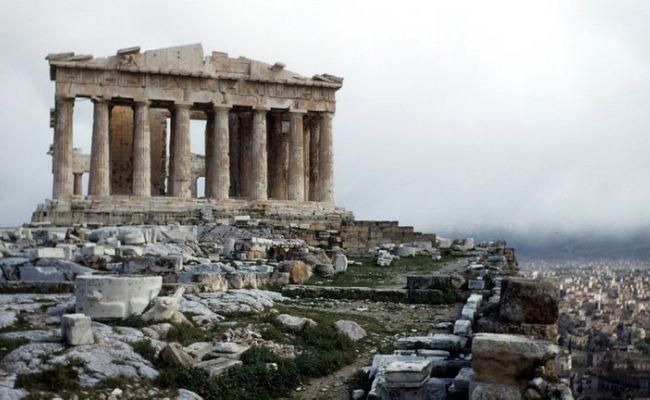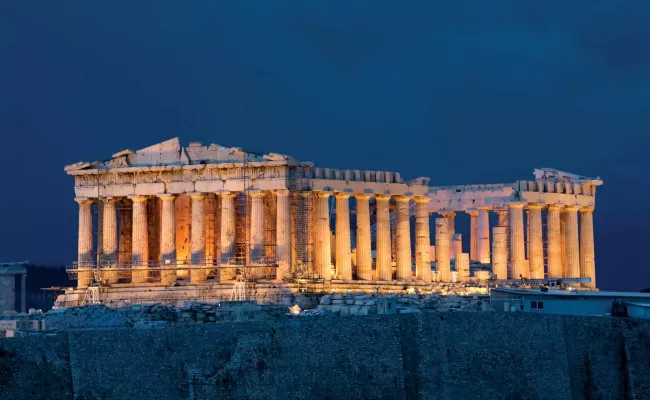The Parthenon, an enduring icon of ancient Greek civilization, sits proudly atop Athens’ Acropolis, a marvel of classical architecture and cultural legacy. Athena, the city’s patron goddess, dedicated this magnificent temple, built between 447 and 432 BC during the height of Athens’ golden period.
The Parthenon, designed by architects Ictinus and Callicrates and embellished with Phidias sculptures, is an example of the Doric order with its majestic columns and ornate friezes. Its historical significance goes beyond architectural quality; it represents Athenian democracy, artistic achievement, and philosophical ideals. Today, the Parthenon is a UNESCO World Heritage Site and a beloved icon of Western civilization’s cultural and creative legacy.
History
Between 447 and 432 BC, during Pericles’ Golden Age, the Athenian statesman Pericles built the Parthenon, an iconic symbol of ancient Greek architecture and culture, on the Acropolis of Athens. Pericles, the Athenian statesman, commissioned the temple as part of a large building project to highlight Athens’ affluence and might. Athena Parthenos, the city’s patron goddess, received the dedication. The Parthenon, designed by architects Ictinus and Callicrates and embellished with Phidias’ sculptural works, embodies the Doric order with magnificent columns and complex friezes depicting legendary narratives.
Originally used as a religious center for Athenian worship and the site of the Panathenaic celebration in honor of Athena, the Parthenon represented Athenian democracy, cultural pride, and intellectual prowess. The temple underwent several alterations over the years, beginning as a Christian church in the Byzantine era and subsequently becoming a mosque under Ottoman administration. It suffered extensive damage, most notably when Venetian shelling destroyed its center section in 1687.
Lord Elgin removed a significant percentage of the Parthenon’s sculptures in the early nineteenth century, known as the Elgin Marbles, now held at the British Museum. Despite its turbulent history, the Parthenon remains a symbol of strength and endurance, having received the UNESCO World Heritage Site designation in 1987. It continues to inspire adoration and intellectual study, symbolizing ancient Greece’s creative and cultural triumphs while also demonstrating Western civilization’s ongoing influence.

The Architecture
Architects Ictinus and Callicrates, under the supervision of sculptor Phidias, began work on the Parthenon in 447 BCE, finishing it in 438 BCE with the installation of a great gold and ivory figure of Athena inside. External ornamentation lasted until 432 BCE. Despite centuries of damage and the loss of much of its original sculpture, the Parthenon’s fundamental structure of white marble has survived astonishingly well. A colonnade of fluted columns supports an entablature with a simple architrave, a frieze of triglyphs and metopes (many now lost), and triangular pediments with relief sculptures make up its design.
The temple’s original interior consisted of a walled rectangular cella divided into three aisles by smaller Doric colonnades, with natural light entering via the east entrance. A smaller chamber was adjacent to the cella, which was approached from the west. Architectural refinements such as the upward curve at the extremities of the base and entablature, the slight convexity (entasis) of the columns to offset visual distortion, and the thickening of corner columns enhance the Parthenon’s sculptural attractiveness and lasting architectural significance.
The sculptures
The sculpture that adorned the Parthenon worked in perfect harmony with its construction. High relief carvings adorned the metopes above the outer colonnade, depicting fabled conflicts from the Greco-Persian Wars, in which the Greeks ultimately triumphed despite suffering their losses.
The east metopes depict Gigantomachy, a fight between gods and giants; the south metopes depict Centauromachy, a conflict between Lapiths, legendary inhabitants of Thessaly, and centaurs; and the west metopes depict Amazonomachy, a combat between Athenians and Amazons. Nearly all the sculptures in the north have disappeared, despite their depiction of the Greeks’ defeat of Troy. The two pediments have intricately carved statues in the round. The only remaining groups in the east witnessed Athena’s birth. On the right, three feminine figures—maybe goddesses—sit together, one resting on the lap of another.
The contours of their bodies are evident beneath the flowing cloth, and their poses become more reclined as the statues approach the narrow points of the triangular pediment. On the west pediment, Athena competes with the sea deity Poseidon for dominance of the region surrounding Athens. The inner part of the Parthenon has a continuous low-relief frieze across the top of the outer cella wall, which most likely depicts the Panathenaic procession of citizens honoring Athena. On the west end, officials and young men mount their horses, and citizens form loose groups. The pedestrians become more congested, and the cavalcade appears to gather up speed, with horses galloping toward the east end, where the frieze ends with an Athena priest and priestess flanked by two sets of seated gods. The entire painting is a masterpiece of composition and clarity, complemented with color and bronze accents.
FAQ
What is the Parthenon and why is it important?
The Parthenon is a temple, dedicated to Athena, the goddess of wisdom and war, and it stands as a monument to democracy that has withstood the trials and tribulations of history
Why was the Parthenon destroyed?
After the Ottoman conquest in the mid-fifteenth century, it became a mosque. In the Morean War, a Venetian bomb landed on the Parthenon, which the Ottomans had used as a munitions dump, during the 1687 siege of the Acropolis.
What God is the Parthenon for?
The Parthenon on the Acropolis of Athens was built between 447 and 438 BC as a temple dedicated to the goddess Athena Parthenos.
Is the Parthenon Greek or Roman?
The Pantheon and the Parthenon are both ancient temples. While the Pantheon was built in Rome to celebrate all the Roman gods, the Parthenon was built in Ancient Greece for the goddess Athena.
